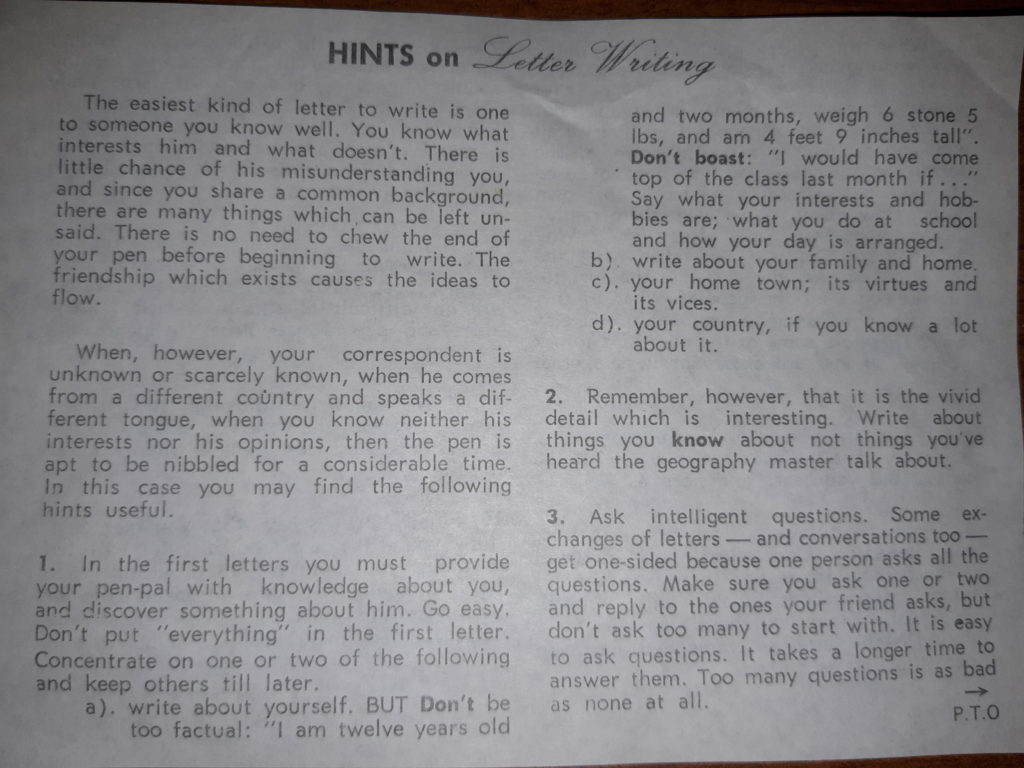From an undated document circa 1989:
The easiest kind of letter to write is one to someone you know well. You know what interests him and what doesn’t. There is little chance of his misunderstanding you, and since you share a common background, there are many things which can be left unsaid. There is no need to chew the end of your pen before beginning to write. The friendship which exists causes the ideas to flow.
When, however, your correspondent is unknown or scarcely known, when he comes from a different country and speaks a different tongue, when you know neither his interests nor his opinions, then the pen is apt to be nibbled for a considerable time. In this case you may find the following hints useful.
- In the first letters you must provide your pen-pal with knowledge about you, and discover something about him. Go easy. Don’t put “everything” in the first letter. Concentrate on one or two of the following and keep others till later.
- a) write about yourself. BUT Don’t be too factual: “I am twelve years old and two months, weigh 6 stone 5 lbs, and am 4 feet 9 inches tall”. Don’t boast: “I would have come top of the class last month if …” Say what your interests and hobbies are; what you do at school and how your day is arranged.
- b) write about your family and home.
- c) your home town; its virtues and its vices.
- d) your country, if you know a lot about it.
- Remember, however, that it is the vivid detail which is interesting. Write about things you know about not things you’ve heard the geography master talk about.
- Ask intelligent questions. Some exchanges of letters — and conversations too — get one-sided because one person asks all the questions. Make sure you ask one or two and reply to the ones your friend asks, but don’t ask too many to start with. It is easy to ask questions. It takes a longer time to answer them. Too many questions is as bad as none at all.
- When the penfriendship has got under way, writing becomes less hard work. Take a pride in what you write, however. Don’t write vaguely as many grown-ups do: “There were a lot of people there and we all had a nice time” is a typical example. The person who writes like that has not used his eyes and is not interested in his own letter. How many people were there really? Did everyone have a “nice time”? Why didn’t they? Can you remember what the place looked like, the curtains, the furniture and above all the people? What in this would be interesting to your pen-friend anyway? These are some of the questions to ask yourself. If you are observant it is a great help.
- If you are trying to describe something remember that the eyes are only one of the senses. Use your ears and nose as well.
- From the above, a central principle; one interesting thing talked about in detail is much more interesting than a number of things talked about quickly and superficially. Only where you share a certain background is the latter recommended and even there the first is better.
- Don’t forget the existence of lending libraries, reference libraries and reading rooms. Magazines, books and large scale maps can help you to see your pen-pal in his environment. Even if you are writing to a cousin of the same nationality in the next town you’d be surprised how much you can learn in this way.
- The unusual is always a source of interest. Drawings, newspaper-cuttings, bus tickets, post cards, snap-shots and stamps are not difficult to slip in a letter. Magazines and papers are quite cheap to send by post.
- If you can write amusingly it is a great help. Be careful, however; it is easy to misunderstand. And don’t write when you are miserable.
- Finally, always say what you feel if you think you will not offend, but don’t pretend to things you don’t feel in order not to offend. Remember you are different from anybody else and so is your penfriend. Respect what you feel and respect what he feels too.
IYS
International Youth Service
PB 125
SF-20101 Turku 10
Finland

